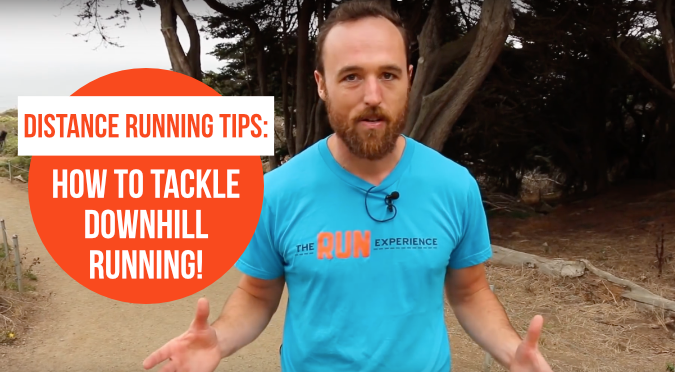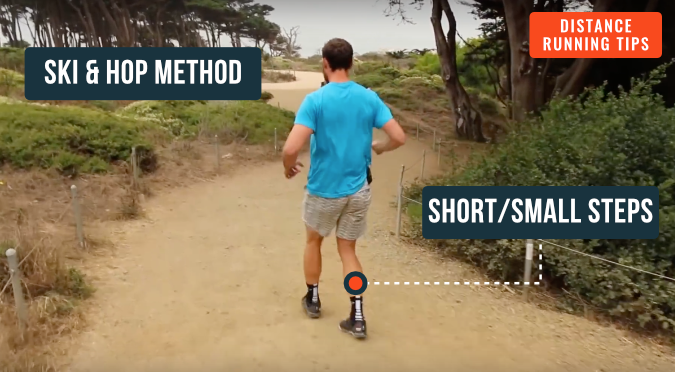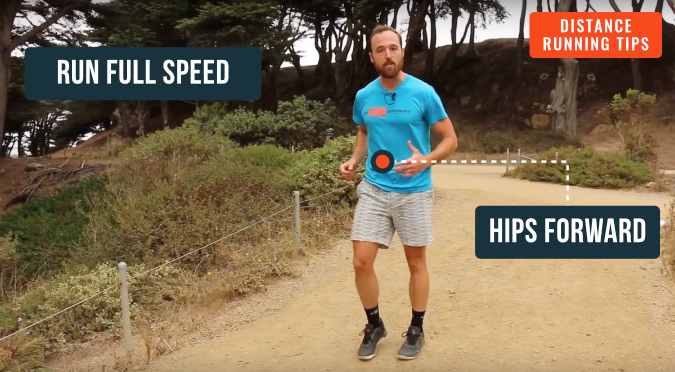Downhill Running Technique: How to Run Down Hills With Ease
Running downhill can be tricky and difficult to tackle. Learn how to run downhill with our advanced tips and techniques.

We were probably all there once – five years old, running downhill with no pain. All we knew was that it felt a lot easier to run down the hill than it did up it. As adult runners, we know it’s not that simple anymore. We’re here to help you learn efficient downhill running technique to make you feel young and reckless again.
Downhill Running Technique Isn’t Autopilot
Elevation change on your run course can be a blessing and a curse. Downhill sections can help break up a monotonous run, and can even help build strength in your lower legs.
Sure, the uphills are harder to breathe on…but for many of us, the downhills are WAY more painful.
Downhills require us to run faster and pick up our cadence, all at the mercy of gravity.
Often times, these downhills can be over a mile long, at least.
The result? A brutal pounding on your lower body, including your quads, knees, and hamstrings–resulting in painful soreness and increasing your injury risk.
So let’s figure out how to best tackle these guys, with the least amount of wear and tear on your body.
How to Run Downhill
There’s “getting” down the hill, and there’s running down the hill.
We’ve all done it…we lean on the downhills (quite literally) as our rest periods. A place to catch our breath.
Downhills are NOT your rest periods! In fact, you’ll want to be even more turned on here than you are on the flats!
Getting down the hill:

- We call this the “skip hop” method.
- Short little steps, perhaps, skips–and braking when you feel out of control.
- Arms tend to flail out to the side, almost like wings.
- You’re essentially gliding down the hill, to the best of your abilities.
- Every step is your attempt at fighting gravity, obstacles, slick surfaces, etc.
Proper running technique down the hill:

- Drive your hips forward.
- Lean forward slightly and drive each step with a high, quick heel pull.
- Turnover should be VERY high.
- As soon as your foot hits the ground, it’s coming off of it again.
- Running should feel light and quick, but full and “complete” in form.
So how do you determine your approach?
Types of Downhills
For the purpose of easier explanation, we’ll use the terms “runnable” and “unrunnable”.
Bear with us and our made-up words 🙂
Runnable Downhills
- Not dauntingly steep
- Requiring a pace not more than 1 min/mile faster than your flat pace
- Fairly clear of obstacles
- Fairly dry (little to no mud, snow, ice, etc)
Running Technique for Approaching These:
Rundown them! Use that high heel pull, quick steps, and a strong hip drive to run fast with great form.
Unrunnable Downhills
- A very steep hill
- Requiring a pace that’s 1-2+ mins/mile faster than your flat pace
- Maybe cluttered with obstacles: tree roots, rocks, gaps, puddles
- Maybe wet, muddy, snowy or icy
Running Technique for Approaching These:
Our good old “skip hop” method. Feel controlled in your footing as you get down this dicier type of hill.
The beauty of running outdoors is that more often than not, the terrain is ever-changing.
How to Master Downhill Running Technique
Mastering the technique for downhill running can greatly enhance your racing and training, allowing you to descend with control, speed, and minimized risk of injury. Implementing an effective downhill running strategy involves a blend of form, control, and training.
Here's a guide to help you master your downhill running technique:
1. Proper Form and Body Position:
Embrace a slight forward lean from your ankles and employ short, quick strides to navigate downhill terrains effectively. Ensure your foot lands beneath your center of gravity, adopting a midfoot strike and keeping your arms slightly wider for balance. Maintain a steady and controlled rhythm, synchronizing your arm movement with your strides.
2. Engage Core Muscles:
A stable and engaged core will facilitate a balanced descent, keeping your torso steady and minimizing unnecessary lateral movement. Ensure that your hips, knees, and ankles are harmoniously aligned to optimize the distribution of force during downhill running. The core acts as a foundational base, connecting and coordinating the upper and lower body.
3. Relax and Stay Loose:
Maintain a relaxed posture in your shoulders, hands, and jaw to prevent unnecessary tension and facilitate smooth running. Staying agile and loose enables your body to adapt quickly to varying terrain and preserves energy and fluidity in your movements. A relaxed body allows for instinctual and effective adaptations to the downhill path.
4. Mindful Braking:
Employ your leg muscles, particularly your quads, as brakes to control your speed, ensuring a manageable and safe descent. Be mindful to distribute braking forces throughout the legs, involving hips and ankles, to avoid overloading the knees. An evenly controlled braking mechanism reduces the risk of injury and enhances stability.
5. Focus and Anticipation:
Keep your gaze several feet ahead on your path, enabling you to anticipate and navigate upcoming obstacles or terrain changes. Strategically selecting the smoothest and most stable route, even if slightly longer, can enhance speed and safety. Visual anticipation allows for timely adjustments and optimizes path selection.
6. Training Your Quads and Calves:
Strengthening exercises for quads and calves facilitate enhanced control and power during downhill running. Incorporating eccentric exercises, which emphasize muscle lengthening, will prepare your legs for the unique demands of descending. Robust leg muscles support stable and efficient downhill movement.
7. Practicing the Descent:
Engage in regular practice on varied downhill gradients and surfaces to build familiarity and adaptability. Training on different slopes enhances your body’s ability to manage varied descent challenges and builds confidence. Practice allows for refinement of technique and boosts downhill proficiency.
8. Footwear Consideration:
Select shoes that provide ample traction and appropriate support for downhill terrain. A good grip is vital for managing potentially varied and slippery surfaces, while adequate cushioning and support safeguard against impact. Suitable footwear is paramount for optimizing performance and minimizing injury risk.
9. Managing Speed:
While gravity naturally propels you forward, maintaining a manageable and controlled speed is crucial for safety and endurance. Aim to sustain a consistent pace throughout your descent, preventing premature fatigue. Speed management ensures a balanced and sustained energy output.
10. Mental Preparedness:
Building confidence through visualization and practice is key to successfully mastering downhill running. Acknowledging and progressively addressing fears related to downhill running is vital for mental preparedness. Confidence and mental poise significantly influence physical performance and enjoyment.
Make Running Downhill Your Strength
Incorporating these downhill running tips will help you to consciously approach these changes with great form…all resulting in injury-free running!
For sticking with us to the end, check out our exclusive running training plan! Running, strength & mobility workouts designed JUST FOR YOU! No gym required.
